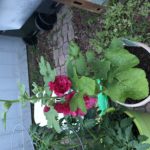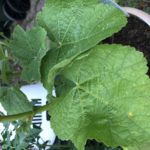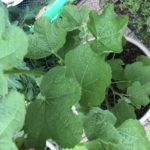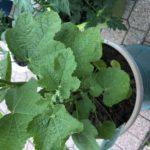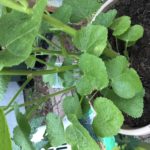Q.Hollyhock Rust
Dear GKH Expert,
I have a beautiful Spring Celebrities Crimson Dwarf Hollyhock which is in the process of blooming flowers but it appears to be infected with rust. I have never bought this type of plant before; it was on clearance at Lowe’s and the picture of the flower on the information tag looked pretty so I decided to give it a try.
I recall seeing the yellowish spots on the larger leaves when I first purchased the plant but didn’t think much of them. Now, the spots have spread all over the plant and after researching online, I’ve come to realize it is a problem. The larger leaves have larger rust spots and the smaller leaves have tiny pinhead size spots all over (see attached pictures).
The only treatment I’ve done so far is I sprayed the top and bottom of the leaves with Garden Safe Fungicide 3 and cut off the larger leaves that had the large rust spots. Several websites I’ve come across say I need to remove all the infected leaves, but if I do that then how will my plant survive with out foliage?
Should I pluck off all the leaves so the plant is just a stem with flowers? Will it eventually die that way? Should I continue to use the fungicide in an attempt to kill the rust?
I would appreciate your advice on what to do with the plant since the rust has spread over the majority of the leaves. I did not know my plant was sick when I bought it but it’s so beautiful and I’m really hoping I can save it somehow. Please help!
Thanks!
Emily

Certified GKH Gardening Expert
Alright... I apologize in advance but this will be a long winded response.
Lets address the issue at hand first, and how it got there. So, places that are not actual gardening centers (as in this being their primary focus) will not give these proper care. Often they are overwatered, and this is where the fungal infection starts. This will slowly progress in your container, and eventually kill off this first plant.
Now, as there is almost no way to sure the existing plant, I do have a solution. Knowing the growth habit, and reproduction cycle of this plant will come to play to your advantage.
Hollyhocks are biennials... This means that their first year is spent with vegetative growth only. The second year is spent flowering. They die after completing reproduction. The good news is that you will have hundreds of seeds make it next year.
Now. In order to ensure that this does not happen in subsequent years you will want to completely throw out that infected soil. There is no reason to try and re mediate this soil. Make sure to sterilize all pots with vinegar, or peroxide, or even both!
Use fresh soil to plant any seeds that come from the flower heads as they die off. The first year's growth will show now flowers, but the second's will. You can, then, start the cycle all over.
Make sure to have plenty of drainage in your container. Make sure there are holes for extra water to escape, and that your mix is well aerated. Only water when the top of the soil is almost completely dry. This will keep infections from starting in the future.
At the beginning signs of any infection, it is best to add dolomitic lime, and wettable sulfur to the soil. This will kill off and prevent most infections, as long as they are not too far developed.

Hollyhock rust is so common that some consider it inevitable. Your plant may have been infected when you purchased it so consider returning it. Treatment is a combination of removing badly infected leaves, fungicides, good air circulation and avoidance of overwatering. All plant parts must be removed at the end of the season or rust will over-winter. Rust has the potential to affect other plants in the Malvaceae family. If you have these in your garden, it may be worth throwing the plant out (or returning it). Here is detailed information on rust and its control. It is unlikely that you'll be able to "cure" this problem so trying to minimize its presence is the goal. https://www.rhs.org.uk/advice/profile?PID=564

